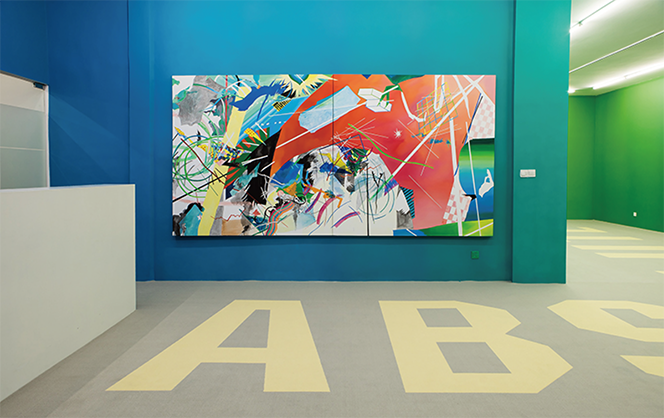
个展《穹顶/Absolute》现场,Vanguard Gallery,2016年3月,摄影:郭波。
Installation view of Absolute, Vanguard Gallery, March 2016. Photo: Guo Bo.
Jiang Jun: Rongrong, how did you choose the title Absolute (qiongding) for this exhibition?
姜俊: 蓉蓉你为什么这样命名你的展览《穹顶/Absolute》?
Bi Rongrong: For the Chinese name, qiongding (lit. dome) was one feature that appeared in the materials I prepared. At the time, I was thinking I wanted to use something from the materials as the name to reference one of the fragments. The English title, Absolute, was a word that fluttered through my mind as I was in the process of making the works. The word itself is quite popular, and also very powerful. In the same way that all the different kinds of elements I collect for my exhibitions are familiar to people, the way they come from our daily lives, I thought that this word had a certain equality with my works. And in terms of the power of the word, I thought qiongding was comparable.
I’m rather curious how you understand the title of this exhibition?
毕蓉蓉: 先说中文,穹顶是我这次诸多采集的素材中,其中一个素材,我当时就想说用其中的一个素材来命名,就好比是画面中的一个碎片。英文Absolute则是我在做作品的过程中,闪入脑海的一个词。这个单词本身很流行,而且特别有力量。就如同我收集的各种元素也是人们非常熟悉的,来自我们日常生活,因此我觉得这个词与我的作品之间有某种对等性。在力量上,也跟穹顶是不相上下。
我比较好奇的是你如何看待这个展览题目?
Jiang Jun: My first impression for the word qiongding is to connect it with the Christian religious tradition. In general, the architecture of vaulted ceilings traces back to Western religious structures like the Cologne Cathedral or the Pantheon in Rome. Domes are formed above their supporting pillars to enclose a vast interior space that can be understood as the intermediary between the secular and heavenly worlds. Even today, churches and temples can still be viewed as the earthly offices of one or many gods. In order to establish their divinity, they must separate themselves from secular spaces, creating a link to heaven in the mortal realm. These hallowed spaces serve as intermediaries to a higher realm and convey the gospel of the other side. The domed ceiling of a church is the zero degree of the transition from secular to spiritual realms.
In terms of the English name Absolute, I think first of Hegel’s “absolute spirit” (der absolute Geist). This philosophical concept also has a theological origin, for it is well known that Hegel’s historical philosophy was itself an expansion of Christian salvation. It can also be understood as Plato’s “platonic idealism.” In the Western context, these theories naturally imply so called “transcendence,” which is to say, only by departing from profane states is it possible to pass onto the other side and reach what Hegel called the “absolute spirit” or the ultimate logos (the word of God). Because “absolute” has an affinity with concepts such as perfection, the supreme, the otherworldly, and the eternal, it was later translated into the supreme spiritual force. Therefore, to a certain extent, both qiongding and absolute actually express the aspiration to reach (for example, by ascending through the dome of a church) a higher plane . While they imply ascendance, they are also a form of sublimation.
姜俊: 首先,提到穹顶,会让人联想到基督教的神学传统,基本上穹顶式的建筑都是来自于西方宗教建筑,比如,科隆大教堂,罗马的万神殿,穹顶连接着承重柱拔地而起,形成一种对广阔室内空间的围合,它可以被理解为是凡间通向天国的中介。直到今天教堂和神庙都可以被理解为是上帝或众神在凡间的办事处。由于要营造它的神圣性,就必须要隔绝于世俗的空间,即在尘世中制造了连接天堂的圣域,并通过这个神圣空间作为中介自上而下地传达彼岸的福音,就如同我们在万神殿中看到的那倾泻下来的光。在教堂中的穹顶正是尘世过渡到神圣的彼岸的那个零度水平面。
再来说Absolute,它的中文翻译是“绝对的”,让我首先想到黑格尔的绝对精神(der Absolute Geist)。这个哲学概念同样拥有类似的神学渊源,因为众所周知黑格尔的历史哲学本身就是一种基督教救赎过程的展开,同时也可以被理解为柏拉图理念的世界中“绝对的理性”(Idea)。在西方语境中,其背后含有的当然就是那个所谓的“超越性”,也就是说,只有摆脱世俗的状况,才可以向彼岸超越、那样才能达到黑格尔的所谓的“绝对精神”,或者是绝对的逻各斯(上帝之言)。因为“绝对”这个词本身是跟完美的、至上的、彼岸性的、永恒的这些词亲缘,它在之后被转译为至高的精神力量。于是,在一定程度上,这个穹顶和绝对的双重诠释反而有效地表达了,有一种通过中介(教堂上升的穹顶)达到彼岸的意向,它蕴含着超越性,同时也是一种升华。
Bi Rongrong: I see. That brings us to the exhibition space and the works. Can you discuss your impressions?
毕蓉蓉: 明白,那联系到展览的空间和作品,你可以谈谈你的观感吗?
Jiang Jun: Your exhibition space is realized in a unique style. It does not look like other exhibition spaces that are simply three-dimensional cubes with a few paintings hung inside. You are presenting a spatial experience. It is a project with a strong feeling of unity as the presentation of each work, including the video, the walls, and the carpet, adheres to a single atmosphere. Using the theme of a “dome,” the exhibition seems to become a metaphor for your own personal church. The geometric composition and the environment of the colors made me think of the transformations and intensification of color in a church’s stained glass windows. As you’ve said, all the modeling of the works is actually derived for your life experiences. Your handling of the entire exterior of the space, in comparison to the gray of the derelict factory spaces in M50, truly creates an artificial separation. This unified work could be thought of as your transformation of the daily, the overlooked, the invisible, or the influences that touched you, into a work. It could also be said that it is a work that takes the fragmented feelings of daily life and transitions them into the realm of art.
姜俊: 你的展览空间是用特殊的方式来呈现的,不像别的展览只是在白立方空间中挂几幅画,你展示的是一种空间性的体验感,它是一个整体性很强的项目,每张作品,包括视频和墙面、地毯的处理都烘托出一种氛围。通过“穹顶”的点题,它似乎可以转化为毕蓉蓉你个人的教堂的隐喻。展览中彩色的几何构成和环境让我想到的是对教堂中彩色玻璃的变形和强化。据你所言,所有作品中的造型部分其实都源自你所经历的日常生活,你的处理在对外面整个区域的空间来说——相对于M50灰色系的旧厂房空间——的确营造出了一种人工的隔绝。这一整体性的工作可以被认为是,你把日常的、被忽略的、不可见的,或某些能触发你的影像转换为作品,也可以说,一种把日常感性碎片引渡到艺术彼岸的工作。

Spatial color design for Absolute.
《穹顶/Absolute》的空间色彩设计图
Bi Rongrong: That’s right. To take an example from the materials I collected, there was an architectural pattern that I saw on a brick from ancient Babylon while visiting the Pergamon Museum in Berlin. After I took a photo, I started to modify it, silk screening it or painting parts of it or incorporating it into an animation. There were also many elements that were taken from graphic design motifs I saw on the street. You know, European streets are covered in all kinds of posters full of all kinds of information and designs. Sometimes it’s more interesting than going to a gallery to look at works. This was often how I immersed myself in an urban environment. When I expressed this feeling in the exhibition, I tried to use the colored space to create a unified atmosphere out of the independent works. I wanted to give that feeling of immersion I had to audiences. I think this may be what made you think of the feeling of color that churches have.
毕蓉蓉: 对,关于我收集的素材,举几个例子吧,比方说有建筑纹样,我在柏林的佩加蒙博物馆看到一个古巴比伦文明时期的一个砖墙上的建筑纹样,我拍下来后,然后把纹样再进行整理,再用丝网印刷印出来,或者画成一个局部,或者放到动画中。也有不少素材採自街头一些海报中的一些图形,你知道的,欧洲街头有很多各种各样的海报,充斥着各种各样的信息和图形,有时这比去一个画廊看一些作品要有意思。我经常就是会如此的沉浸在一个城市环境中,当我在表达这种感受时,比如在这一次展览中,我有尝试用这样的一个色彩空间使这些独立的作品之间形成一种整体氛围,希望把这种浸入式的感受带给观众。我想这就是为什么让你联想到彩色的教堂这样的一种氛围的感受。
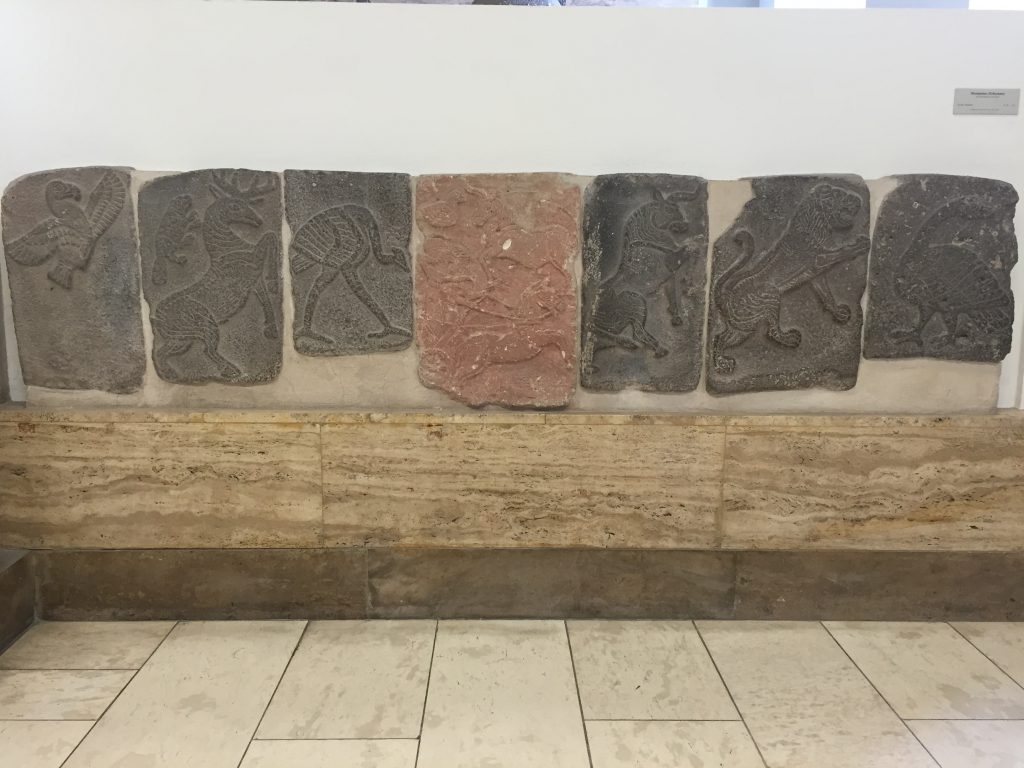
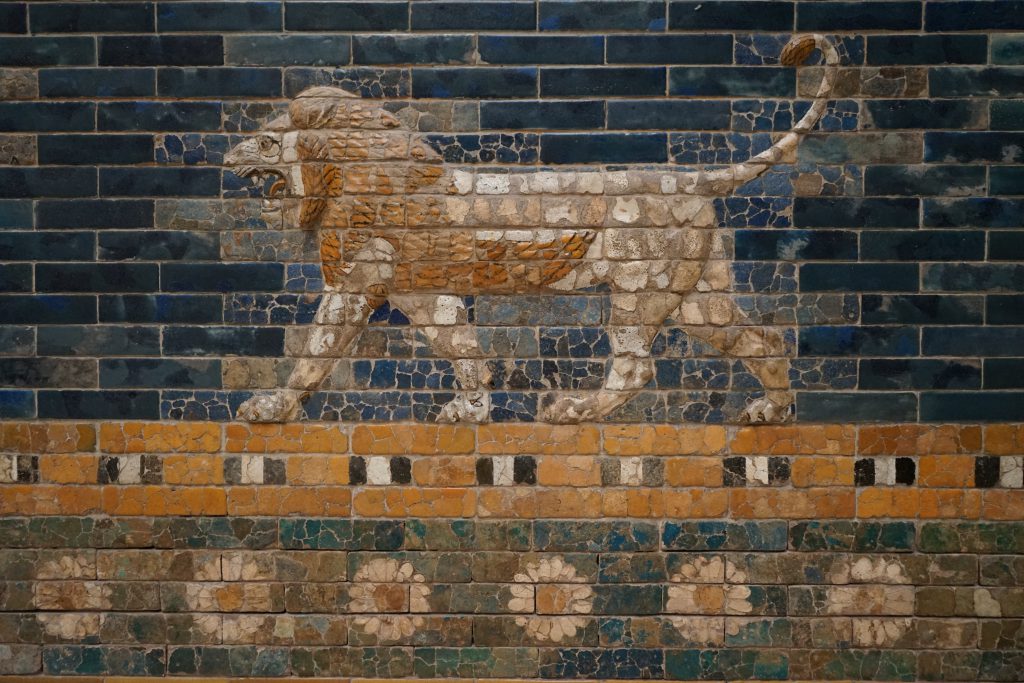
Material collected by Bi Rongrong while traveling. Photograph from the Pergamon Museum, 2015.
毕蓉蓉在旅行中收集的素材:摄于柏林佩加蒙博物馆,2015
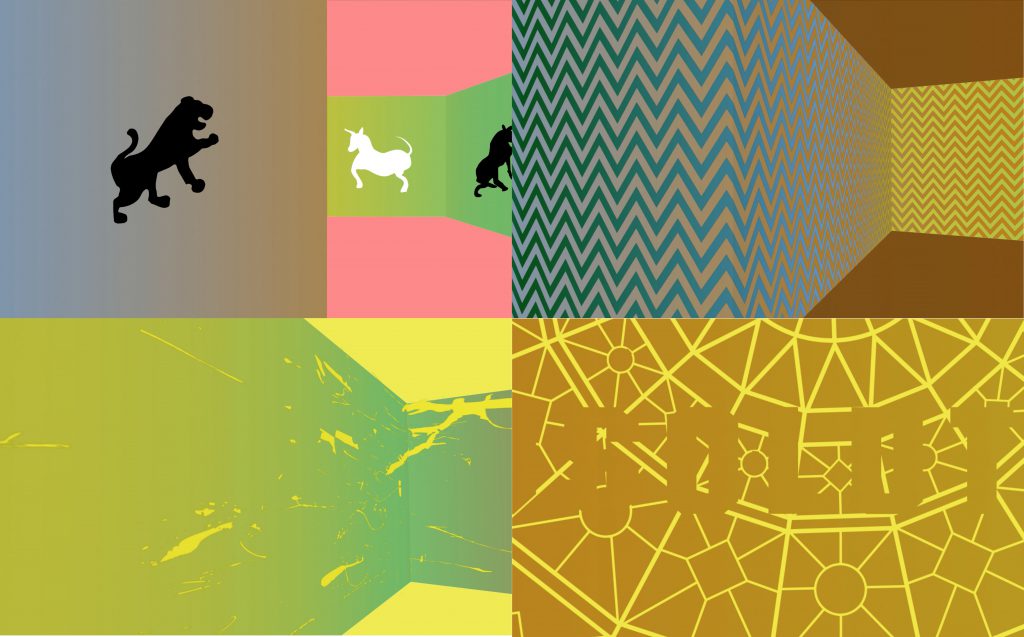
Video work, Absolute 15/16, 48’’. 2016
作品 《穹顶 15/16》截图,48’’, 2016
Jiang Jun: I’ve heard you say that each portion of the modeled painting is drawn from a different location and they are all places you personally experienced, so they contain memories. Knowing this backstory gave me a further recognition and feeling for your exhibition. When I did not know, I thought the work was very visual. So I want to ask whether you need to make an explanation or documentation of your handling of the images when you show these works. That way, we could see how these fragments have been modified and installed in your “church.” You also use a bidirectional interpretation, qiongding and “absolute” in your title. I think that people will need to indicate the source in order for people to understand that your artistic practice relates not to those dazzling visual effects found in all kinds of fashion magazines and advertisements, but rather, to the process of turning the daily into the sacred.
姜俊:因为我听你说你的那些画中的每个造型分别来自不同的地方,也都是和你切身经历有关的场所,饱含着记忆。有了这些故事会让我对这个展览有进一步的认识和感受。在不知道的情况下,我会觉得它很视觉。所以我会问,在展示作品的时候你是否有必要对你图样的出处做一个说明,或者文献化的展示。这样我们就可以看到你如何把这些碎片通过某种加工,放到你的“教堂”中去。而你又在标题中用了穹顶和Absolute的双向诠释,因此我觉得,如果把出处标明,大家才会明白你的艺术创作涉及到将日常神圣化的过程,而并非是那些在各种时尚杂志和广告中眼花缭乱的视觉效果。
Bi Rongrong: I have no interest in juxtaposing the original materials and the final works in the exhibition space. I would rather the works themselves stand as an independent whole. They should be pure. When people see these images, they may come up with different associations. As for explanatory texts, there are other ways to transmit such information to audiences, such as on a website.
毕蓉蓉:我并不想把素材和最终的作品在展览的时候进行并置。我还是希望作品本身是一个独立的整体,它应该是很纯粹的,大家看到这些图像,可能会有不一样的联想。至于说明性的文本,可以通过其它的方式传递给大家,比如说网站等。
Jiang Jun: The reason I would like to see these source materials is because we’ve already become numb to magazine design or to the huge number of images we see in lightbox advertisements and electric screens. Going back to your works, on first glance one might think they are beautiful, cool, but nothing more. But if they know the individual story of the artist, there will be a tension that contrasts with the production of meaningless abstract images. This can also help people understand your process of turning decay into mysticism.
姜俊:我为什么会期待看到这些出处呢?因为我们在设计杂志中,大街小巷的广告灯箱和电子屏幕上看到非常多的图样,我们已经麻木不仁。当回到你的作品,可能第一眼会觉得很漂亮,很酷,仅此而已,但如果背后有艺术家个人性的故事,就会和无意义的抽象图样产生反差的张力,也能让人明白你变腐朽为神奇的过程。
Bi Rongrong: Street imagery is actually quite trendy and popular. There’s no difference between it and fashion magazines. Because they try to grab people’s attention and stand out from the mass of magazines, they’re all looking for designs that attract people. When I was in European cities, I was a tourist who only stayed one to three months. Their culture is different from ours, as is their visual experience. As such, it was very appealing to me, so I would pick out materials everywhere I went. In their use of colors, the street posters and graffiti were extremely exaggerated. They would do things like cover a huge area in a neon color. They often use color first as a way to attract attention and second to create form. I moved many colors and forms into my database of materials and once they were there, I carried out a renewed discussion between them in a personal context. These were combined with a new environment, that of the exhibition space. This process involved referencing, copying, and recreating whereas the process of gathering was a process of study. At the same time I felt clearly that many of the images actually had no attributes. They could be used in any situation. When an image can be used anywhere, there’s no point in discussing whose image it ultimately is or what its source was. The images can be quite simple or classical, drawn from Assyrian civilization thousands of years ago or from the graphics on a poster, but when they’re placed together, there’s no actual difference between them. Anyone can use these images. I wanted to take the images that are available to anyone and incorporate them in my work, turn them into my own language. Within my system, they can be put to a new use once again.
毕蓉蓉:街头图样其实很流行同时也很大众,这跟时尚杂志是没有什么区别的,它们要从众多的海报群里引起我们的注意,于是都在寻找一个吸引人的设计方式,当我在欧洲城市中,我是一名游客,可能只待一个月,或者三个月,他们的文化和我们不同,视觉经验和我们不同,因此很吸引我,使得我随时都在采集素材。街头的海报涂鸦在色彩的运用上也会比较夸张,比如大量的荧光色,经常是颜色先引起了我的注意,然后再是形状。我搬了不少颜色和形状到我的素材库里,搬回来以后再在我的个人语境中,重新讨论,然后又跟新的环境也就是展览的环境去结合。这个过程当中,有借鉴、模仿、再创造在里面,这个采集的过程,是我学习的过程,同时我也能很明显的感觉到很多图像其实是没有属性的,它们在任何地方都可以被运用,到处都能用到,这个图像到底是谁的,这个出处到底是哪里,已经失去讨论的意义,这些图像可能非常简单,或者经典,几千年前亚述文明中的或者是海报上的图像,放到一起,其实已经没有区别,图像谁都能用,我只是想把这些谁都能用的图像,放到我的作品,变成我的语言,在我的系统中他们可以被重复不同地使用。
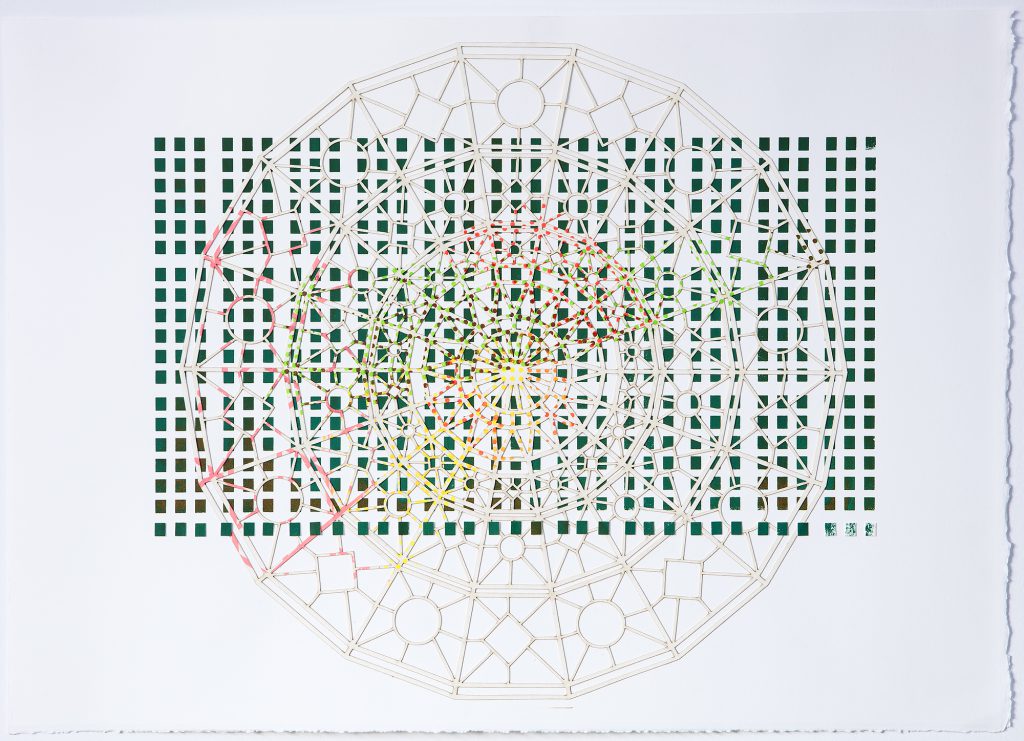
Absolute 06/16, watercolor on paper, silkscreen, and collage, 38 x 53 cm. 2016. Photo: Guo Bo.
《穹顶 06/16》,纸本水彩、丝网印刷、拼贴,38 x 53 cm,2016,摄影:郭波
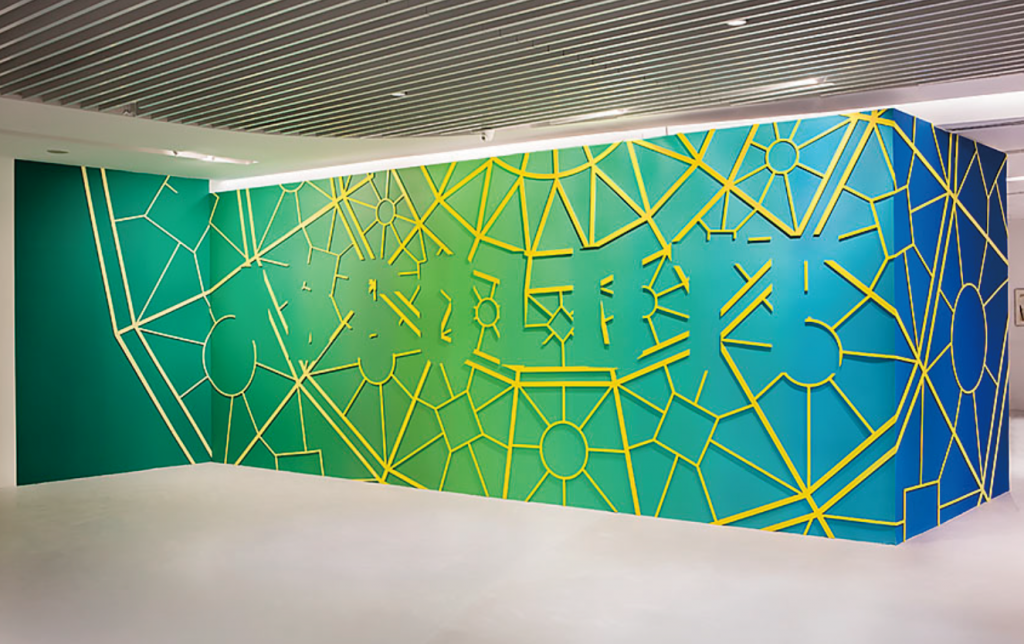
Absolute 1/16, is an onsite work building on the Absolute series, created for Shanghai K11 Chi Museum. Materials: acrylic, PVC. Dimensions on site, 11.5 by 2.8 meters. 2016. Photo: Guo Bo.
《穹顶 1/16》,是个展《穹顶》系列作品延伸出的一件现场作品,
创作于上海K11 Chi美术馆。材料:丙烯,pvc 现场尺寸:11.5×2.8米,2016,摄影:郭波
Jiang Jun: That is to say, you turn these images into modules. Your processing is a reconfiguration of these modules that produces different variations.
姜俊:就是说这些图像变成了一种模块,你的操作是对各种模块的重组,并产生各种不同的variation(变奏)。
Bi Rongrong: Once I have the modules, I use some of them in a large painting. Then new modules are formed from this large painting that will be used in smaller works, and the smaller works may also develop into a larger space. Once it has become a component of a comprehensive whole, no one is thinking about where it was used. In this exhibition there is a collage on paper made from images of an art museum’s domed ceiling I collected while traveling. This was used for a contemporaneous group exhibition at K11, and I expanded a portion of this work on paper for the exhibition space. The background colors, however, are expanded portions of an oil painting in the solo exhibition. They are also used throughout the solo exhibition space. I used the structure of the gallery for the animation in the solo exhibition. In this virtual space, I created a flowing version of the gradient that I sprayed on the walls of the exhibition space. I also used other elements I had collected in order to realize more possibilities in this virtual space.
毕蓉蓉:模块拿过来以后,在一个大画里面用了一些,然后在这张大画里又形成了一些新的模块,接着又拿出来在另一张小画里使用,随后这张小画又可能演变到一个大的空间里。当它在变成一个新的整体的一部分之后,就已经没有人关心它在哪里被使用过。在这次个展中有一件拼贴的纸本作品,所用的素材是旅行中采集的一个美术馆穹顶图案,于是在与个展同时期的K11的群展中,我将这件纸本作品的局部放大到了展厅现场之中,所用的背景彩色则是从个展中的一件布面油画作品的局部扩展而来,同时也用在了个展的整个展厅之中。个展中有一件动画作品,我采用了展览的画廊空间的结构,将我在真实的展厅墙上喷绘的渐变色在这个虚拟空间中流动了起来,并且把收集的一些元素也运用到了这个虚拟空间之中,来展现一些更多的可能性。
Jiang Jun: It’s able to display modules, 1, 2, 3, 4… so people can recognize them. I think that’s quite interesting.
姜俊:能展示出模块1、2、3、4 ……让大家辨识,我觉得很有趣。
Bi Rongrong: In fact, this kind of arrangement was already implicit in the exhibition. From drawing to painting to video to installation, it resembles the way Chinese traditional painting begins in one place and expands outwards. It is a painting method of emergence. The larger structure may be at the core or it may not have been set in advance, but it extends from this point like a form of “mental travel,”(woyou). I want to move this feeling from drawing to installation, allowing one’s thoughts to drift within the images while also creating a free entity. The emergent process of these images is actually my process of travel. I want to let people use their eyes or their thoughts to travel mentally within the painting. By enlarging the scale of the work, even into an entire space, I hope to bring the body itself into the work so the audience will have more chances to make a connection.
毕蓉蓉:其实这种编排已经在展览中形成了。从drawing到painting到视频、装置,有点像中国画里面从某个点拓展开去,生发式的绘画方式,大结构也许在心中,也许没有事先设定,但是从这一点延伸出去,就像是“卧游”一样,就是我是想把这样的感受通过drawing到installation,能在图像内部让人的思想游动,形成一个自由的整体,这些图像的生发过程,其实是我的“游”的过程。我希望的是让人们能够在我的画面里“卧游”,眼睛也好、思想也好,作品比例的放大,放大到整个空间,是想把身体这一部分也介入,更多一个层次地让观众接近作品。
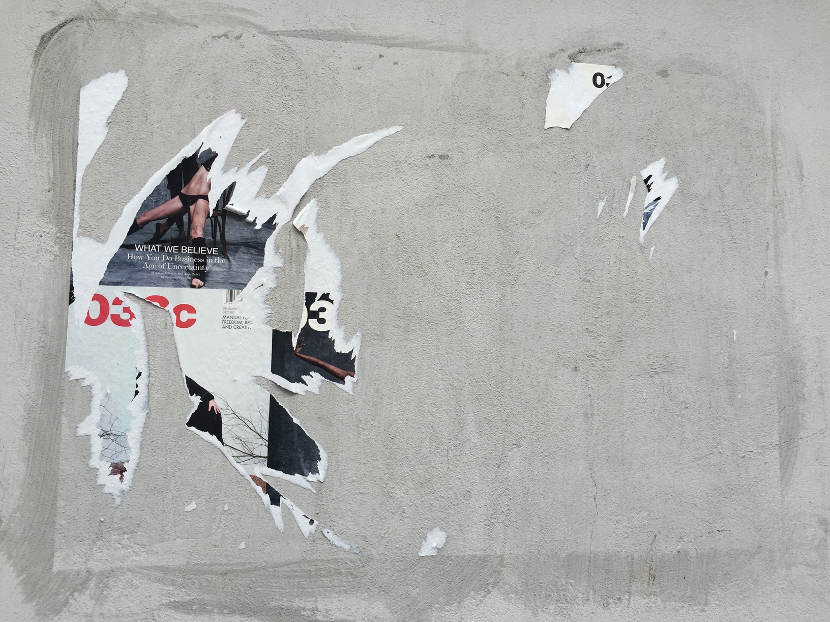
Material collected by Bi Rongrong during her travels. Photo of the outside of UferStudio, Berlin, 2015.
毕蓉蓉在旅行中收集的素材:摄于柏林UferStudio外的墙面,2015
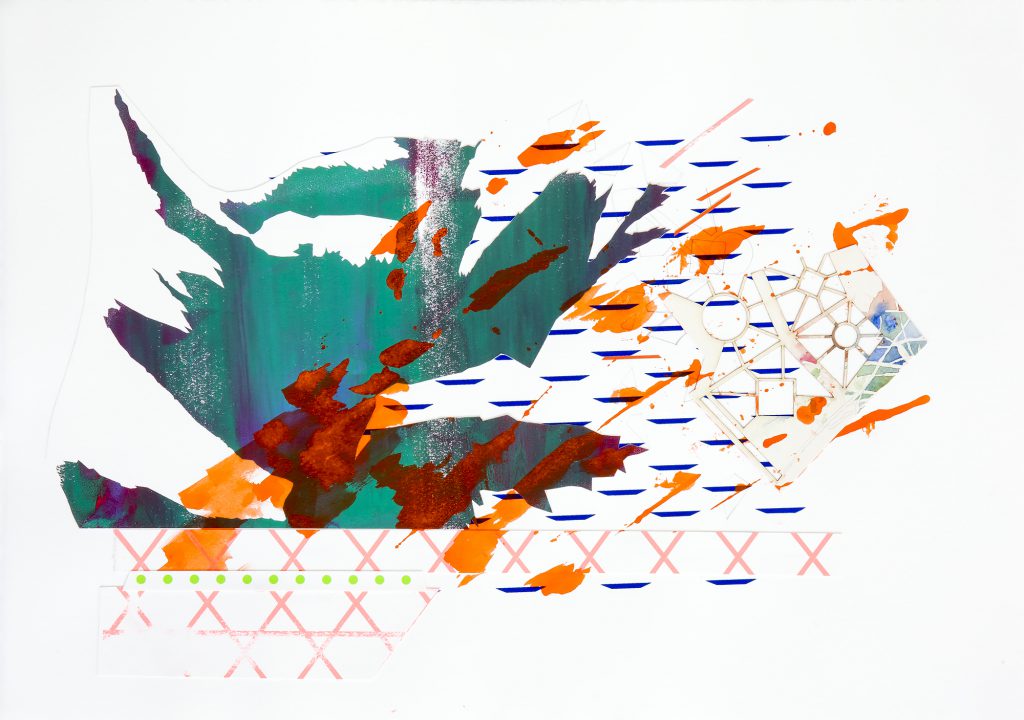
Absolute 07/16
Watercolor on paper, silkscreen, laser cutting, and collage, 38 by 53 cm, 2016. Photo: Guo Bo.
《穹顶 07/16》
纸本水彩、丝网印刷、激光切割、拼贴,38 x 53 cm,2016,摄影:郭波
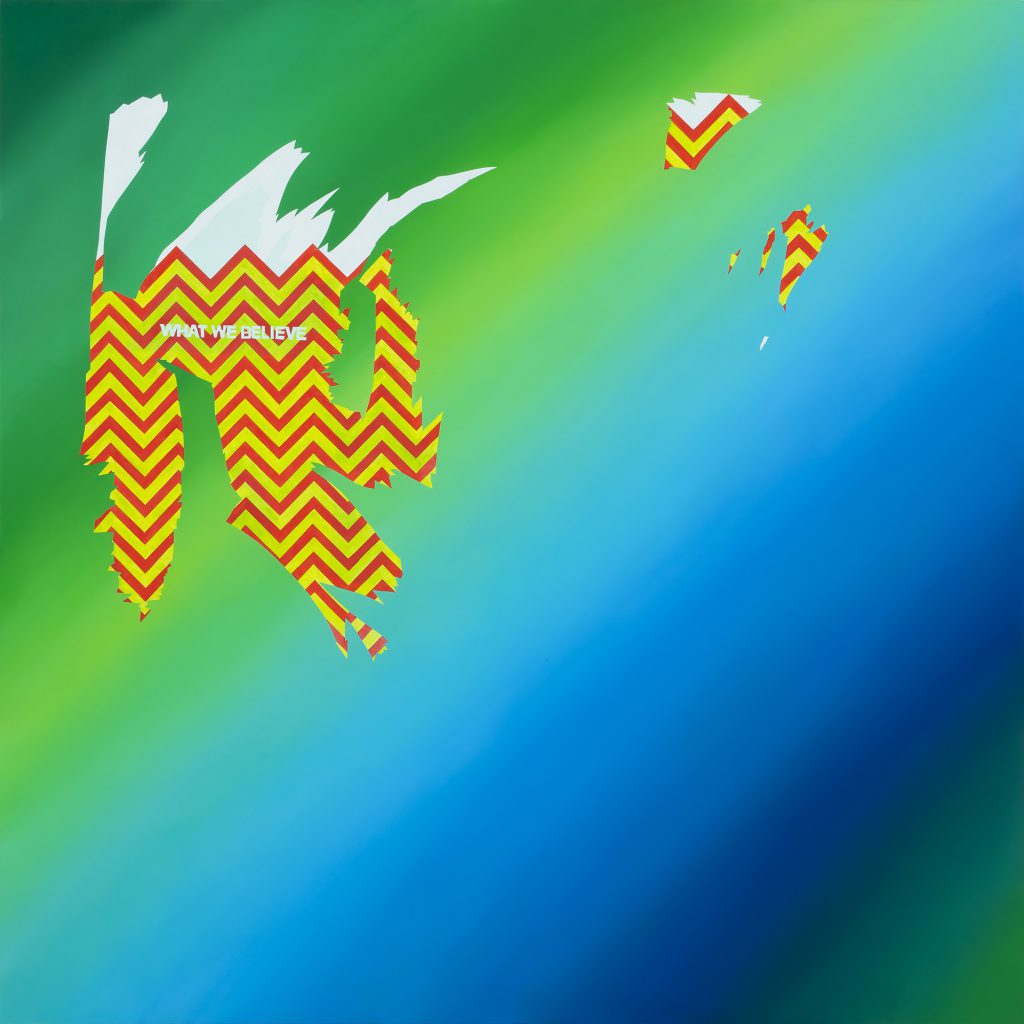
Absolute 03/16
Oil on canvas, 190 by 190 cm, 2016, photo: Guo Bo.
《穹顶 03/16》
布面油画,190 x 190 cm,2016,摄影:郭波
Jiang Jun: Due to your background studying traditional Chinese painting, you certainly know as well that for educational purposes, the modular methods in your imagery are like those described in German art historian Lothar Ledderose’s Ten Thousand Things: Module and Mass Production in Chinese Art (2000), which traces the many appearances of modules (Versatzstück) in Chinese art. You intercept the images you experience in your daily life and turn them into various modules. Like the Manual of the Mustard Seed Garden, they become a system. But the difference is that this is your personal, proprietary modular system. And the myriad combinations of modules, just as described in Ten Thousand Things, create in your work a process by which limited modules iterate limitlessly. This is also an effect of systemized production.
姜俊:因为你以前的国画学习背景,也一定知道,画谱里面有模块式的方法,供教学之用,就像德国艺术史家雷德侯在他研究中国艺术的合集《万物》中所总结的,在中国艺术中大量出现模块化(Versatzstück)操作。你把你日常中经历的图像截取下来,做成不同的模块,如同《芥子园画谱》一样形成一个系统,但区别在于,那是你个人的,即毕蓉蓉专有的模块系统。而万千种模块组合的方式,正如《万物》中所表述的,构成了你作品创作中从有限性模块向无限性聚变的过渡,这也是一种系统化的乘积效应。
Bi Rongrong: Right. It’s already quite developed in the painting.
毕蓉蓉:对的,这在国画中已经非常成熟了。
Jiang Jun: Here we have found a perspective for understanding your work. You turn fragments of daily life into a modular system. This is part of how your language is formed. Through repeated constructions in your work, you shape the limitless possibilities for variation. Rongrong, I think that as you accumulate more and more modules in your life, you can write your own Manual of the Mustard Seed Garden.
姜俊:这样我们就找到了一个可以理解你的作品的角度,你把日常碎片变化为模块系统,成为你形式语言的一部分,并在你的作品中反复重构,形成无限变奏的可能性。蓉蓉,我觉得随着你在生活中积累的模块越来越丰富,你可以编一个自己的《芥子园画谱》。
Bi Rongrong: That’s an excellent idea. I may try that.
毕蓉蓉:这是一个很好的主意,我可以尝试一下。